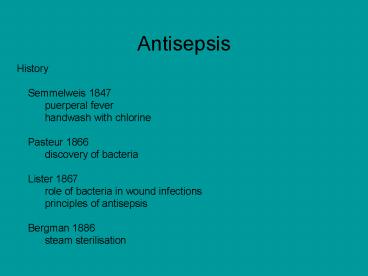Antisepsis PowerPoint PPT Presentation
1 / 17
Title: Antisepsis
1
Antisepsis
- History
- Semmelweis 1847
- puerperal fever
- handwash with chlorine
- Pasteur 1866
- discovery of bacteria
- Lister 1867
- role of bacteria in wound infections
- principles of antisepsis
- Bergman 1886
- steam sterilisation
2
Principles of antisepsis I. Operating theatre
- Isolation of operating suite
- Air-conditioning, bacterium-filters
- Sterilisation (instruments, gloves, drapes etc.)
- Skin cleansing
- - transient and resident bacteria
- - ideal agent
- effective against all micro-
- organisms
- non-irritating
- non sensitizing
- Surgical hand desinfection
- - mechanic and chemical
3
Sterilization techniques
- Purpose elimination of microorganisms
- Steam (Autoclaving)
- instruments, dressings
- Dry heat
- instruments that could be corroded
- Gas
- ethylene oxide
- if heat sensitivity (rubber, plastic
materials, - endoscopic
instruments) - Radiation
- gamma rays
- solutions, catheters, sealed plastic
materials
4
Preparations for operation
- Surgical personnel
- Clothing for operating room personnel
- Hand and arm disinfection (scrubbing)
- Gowning and gloving
5
Preparation of the patient
- Preoperatve tests
- Preoperative diet orders
- Preoperative medication
- Skin preparation
- Positioning on the operating table
6
Preparation of the operative area
- Bloodless field
- Skin disinfection
- Draping
7
Surgical instruments and sutures
- Cutting instruments
- Grasping instruments
- Retracting instruments
- Suturing instruments
- Suture material absorbable and nonabsorbable
- clips and staple
- Electrocautery
8
Principles of antisepsis II.
- Importance of the surgical technique
- - atraumatic, fine
- - proper exposure
- - thorough bleeding control
- - removel of devitalized tissues
- - adequate suture material
- - drainage if necessary
9
Surgical infections
- Cause significant morbidity
- - increase in hospital costs
- - extra workload on surgical
personnel - Definition
- - result of an operative procedure
- - or can be treated only by surgery
- Usually polymicrobial
- Significant tissue reaction
- - erythema, fluctuation, tenderness
10
Origin of surgical infections
- patient
- ward personnel
- operating theatre personnel
- instruments
11
Pathogenesis of infection
- Imbalance of the host defense system
- from
- a. overloading
- b. intrinsic abnormalities
- c. local factors
12
Intrinsic factors increasing incidence of
surgical infections
- Malnutrition
3x - Alcoholism
- Steroids
2x - Diabetes
2x - Poor tissue perfusion
- Anemia
- Obesity
2x - Chronic renal failure
- Malignancy
- Immune suppression
- Hypoproteinemia
- Infection at nonrelated site
3x - Age over 60 years
3x
13
Local wound factors increasing incidence of
surgical infections
- Contaminated wound
6x - Foreign body
- Devitalized or necrotic tissue
- Preoperative hospitalisation
4x - Excessively tight sutures
- Emergency operation
3x - Long operation (over 3 hours) 2x
- Hematoma, seroma,
- Electrocautery
2x - Penrose drain use
2x
14
Prevention of surgical infection
- Most effective and least expensive method
- Careful control of intrinsic and local factors
- Prophylactic antibiotics
- - only in high risk patients
- - improper use
- increased costs
- development of drug-resistence
- serious complications
- (e.g. pseudomembranous
colitis)
15
Proper prophylactic antibiotics
- Short term
- Appropriate timing
- Only if significant risk
- (GI tract,
cardiothoracic, - vascular,
- urogenital, implanted prosthesis)
16
Diagnosis of surgical infections
- Physical examination
- X-ray
- US
- CT, MRI
- Labelled leukocyte (isotope)
- Culture
17
Principles of treating surgical infections
- Local treatment
- Incision and drainage of abscesses
- Removal of the diseased organ
- Debridement (removal of necrotic tissues)
- Colostomy (diversion of feacal stream)
- Antibiotics
- - if systemic manifestation
- - according to cultures

